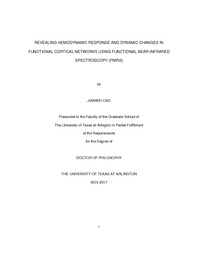| dc.description.abstract | Therapeutic interventions, such as physical therapy and non-invasive brain electrical stimulation can enhance the physical performance of persons with brain disorders. One often-used form of physical therapy named constraint-induced movement therapy (CIMT) improves motor control skills of children with cerebral palsy (CP) through forced intensive use of the affected extremity. A complementary method to physical rehabilitation methods for overcoming a deficit is to facilitate use of the affected brain areas by non-invasive brain electrical stimulation. One currently popular form of brain stimulation is transcranial direct current stimulation (tDCS), which has been shown to enhance both motor and language performance in adult stroke patients. Though many studies have researched how those interventions affect performance, few studies have systematically investigated the underlying mechanisms of how the interventions affect cortical plasticity, which drive the externally observed performance improvements.
To address this knowledge gap, my dissertation work has focused on objective measures of altered hemodynamic response and functional connectivity patterns induced by therapeutic interventions (CIMT and tDCS) on the human brain. Functional changes in the brain were mapped by use of functional near infrared spectroscopy (fNIRS) technology, the design of novel experimental protocols, and the implementation of data analysis algorithms to these studies. My dissertation achieved those goals through implementation of the three following steps:
1) In Chapter 2, my research focused on evaluating cortical plasticity of the sensorimotor cortex in children with CP undergoing CIMT by fNIRS. Brain activation patterns indicated by hemodynamic activity metrics, namely the laterality index, time-to-peak/duration of activation ratio, and resting-state functional connectivity changes were mapped by fNIRS before, immediately after and six months post-CIMT. The fNIRS imaging metrics, acquired concurrently with changes in motor performance, provided insightful information to help explain why some children had better performance after the CIMT intervention and why that performance declined six months later.
2) In Chapter 3, I investigated the altered resting-state functional connectivity patterns of language areas when tDCS was applied over the Broca’s area, which is central to language processing. Transient cortical reorganization patterns in steady-state functional connectivity (seed-based and graph theory analysis) and temporal functional connectivity (sliding window correlation analysis) were recorded before, during and after High Current tDCS (1mA, 10mins). The findings of this work demonstrated that tDCS induced significantly (p < 0.05) increased functional connectivity between Broca’s area and its neighboring cortical regions, enhanced the small-world features of the cortical network globally, and caused significant (p<0.05) increases to the functional connectivity variability (FCV) of remote cortical regions related to language processing. In addition, Low Current tDCS (0.5mA, 2 min 40 s) was found to qualitative predict the increase in clustering coefficient (Cp) and FCV at higher stimulation currents, but not the enhancement of local connectivity.
3) In Chapter 4, my research further explored the direction of information flow by Phase Transfer Entropy (PTE) before tDCS, during Low Current tDCS, during High Current tDCS and after High Current tDCS. The results demonstrated that tDCS induced alterations in information flow from the stimulated Broca’s area and its homologous area in the right brain hemisphere to other language-related cortical regions. In addition, the direction of information flow was examined in three fNIRS frequency bands: endothelial, neurogenic and myogenic. An increase in outgoing information flow was seen consistently for the stimulated Broca’s area for the endothelial frequency band, and the patterns of information flow during Low Current tDCS were similar with those seen after High Current tDCS. Interestingly, a different pattern was seen in the neurogenic frequency band, where the outgoing information flow during High Current tDCS was similar with low patterns seen after the High Current tDCS session. In the myogenic frequency band, there is no significant change in key language areas (Broca’s area and Wernicke’s area), but global patterns were seen that were interpreted as Mayer waves. | |


